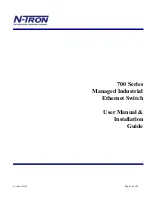
Description of the menu options
ELSA LANCOM Business
R51
SPX-watch
This option allows you to define the type of management used for SPX watchdog packets.
쮿
Route
causes the SPX watchdog packets to be transferred and, consequently, also
causes a regular establishment of connections by means of the server’s SPX
watchdog packets.
쮿
Spoof
(default) causes SPX watchdog packets to be answered locally. This setting
is especially economical.
NetBIOS-watch
This item specifies how NetBIOS watchdog packets should be treated. NetBIOS
watchdog packets occur, e.g., if Windows networks are connected by IPX. The same
options are available as with IPX or SPX watchdog packets (filter, route, spoof).
Socket-filter
The socket filter table permits the selective filtering of LAN packets to specific ranges of
destination sockets. Filtering is performed for both single IPX packets and propagated
IPX packets. The following sockets (which are periodically sent in the network and,
therefore, would result in connections being established too frequently) are already
entered in the LAN filter table as default values (for details, also see FAQs on the
'IPX router').
Loc.-routing
This setting supports the scaling of multiple routers in a local network. When all the
channels for one router are already seized and packets for other remote stations are still
being received at this router, other routers in the LAN may still have free channels.
If the 'Loc.-routing' option is activated, the router forwards the packets in the local
network to a router that has propagated a route to the remote station desired. The router
has saved this route, although it is less efficient than its own, and marked it with the
'reserve' flag in the RIP table.
The default setting for this option is 'Off' since an IPX client sends a RIP request for the
relevant route after a timeout, thus automatically finding a different router through which
it can access the destination network.
RIP-SAP-scal.
Another option for supporting scaling is to propagate every route to which there is an
active connection with a somewhat better tic count than the actual one. This will ensure
that all clients will send their packets for these routes to the router that has the
connection. In addition, in the event that all channels are busy, the routes that are no
longer available will be propagated as 'DOWN'. Because one or more broadcasts are
Start-socket
End-socket
0455
0457
0550
0555
1401
1402
1480
1481
83ba
83ba
900F
9010
Summary of Contents for LANCOM Business LC-4X00
Page 1: ...Manual ELSA LANCOM TM Business No 20857 0999...
Page 4: ......
Page 10: ...Content ELSA LANCOM Business X...
Page 22: ...Introduction ELSA LANCOM Business 12...
Page 42: ...Configuration modes ELSA LANCOM Business 32...
Page 112: ...Operating modes and functions ELSA LANCOM Business 102...
Page 146: ...Workshop ELSA LANCOM Business 136...
Page 152: ...Appendix ELSA LANCOM Business 142...
Page 160: ...Glossary ELSA LANCOM Business 150...
Page 170: ...Index ELSA LANCOM Business 160...
















































